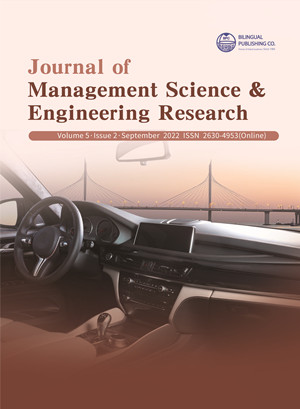-
5354
-
865
-
432
-
431
-
331
Effect of Partial Replacement of Coarse Aggregate with Electronic Waste Plastic in Light Weight Concrete
DOI:
https://doi.org/10.30564/jmser.v5i2.4801Abstract
This study assessed the usefulness of the replacement of coarse aggregate partially with electronic waste (e-waste) plastic in lightweight concrete since developing countries have been challenged with management of e-waste as well as high cost of coarse aggregates for concrete production. Coarse aggregates were replaced with e-waste plastic in concrete at 5%, 10%, 15%, and 20% for a concrete class of C20. The particle size distribution of the e-waste plastic aggregates was determined as well as the slump, compressive strength, water absorption and bulk density of the concrete. Generally, the slump decreased as the e-waste increased. The compressive strengths decreased for the 5% and 10% replacement of coarse aggregates with e-waste but increased for the 15% and 20% replacement of coarse aggregate with e-waste. 0% water absorption was obtained for the 15% and 20% e-waste content while the 10% e-waste concrete obtained 0.01% and the 5% e-waste obtaining of 0.013% after 28days of curing. The densities of 5%, 10%, 15% and 20% e-waste plastic content decreased as compared to the 0% e-waste plastic content. The values of compressive strength obtained showed that coarse aggregate replacements by e-waste plastic at 15% and 20% may be appropriate for lightweight concrete of class C20/25 since compressive strengths ranged between 16.09 Nmm–2 and 22.87 Nmm–2. This implies that partial replacement of coarse aggregate with e-waste plastic may be useful for lightweight concrete as well as helping in eradicating the environment of the menace of e-waste plastic.
Keywords:
Electronic waste; Plastics; Compressive strength; Coarse aggregate; ConcreteReferences
[1] Making electronic waste recycling in Ghana Safe Through Alternative Technology, Pure Earth Blacksmith Institute, Agbogbloshie, Accra, 2016.
[2] Garlapati, V.K., 2016. E-waste in India and developed countries. Management, Recycling, Business and Biotechnological Initiative. Renewable and Sustainable Energy Reviews. 54, 874-881.
[3] Jibreal, F.P., Manhal, A., 2016. Strength and Behaviour of Concrete Containing Waste Plastic. Journal of Ecosystem and Ecography. 6, 186.
[4] Government of Ghana, 2016. Hazardous and Electronic Waste Control and Management Act (Act 917). Ghana Publishing Company, Accra.
[5] Government of Ghana, 2016. Hazardous and Electronic Waste Control and Management Regulation Legal Instrument (LI) 2250. Ghana Publishing Company Limited, Assembly Press, Accra.
[6] Kumi, E., Boateng, P., Ahlers J., et al., 2021. Pathways to formalization in Ghana, E-waste Sector-A policy brief on sustainable approaches to formalization. E-MAGIN Consortium.
[7] Rafat, S., Jamal, K., Inderpret K., 2008. Use of Recycled Plastic in Concrete. A review, Waste Management. 28(10), 1835-1852.
[8] Bentil, J., Nsiah, J.J., 2016. Utilization of Plastic waste bags as concrete additives. International Journal of Scientific & Engineering Research. 7(7), 801- 804.
[9] British Standard Institute. Structural Use of Concrete-Part 1: 1997., Code of practice for design and construction, London: British Standard Institute Publication.
[10] Ashwini, M.B.T., 2016. Partial Replacement of E-plastic waste as Coarse Aggregate in Concrete. Procedia Environmental Sciences. 35, 731-739.
[11] Zeeshah, U., Muhammad, I.Q., Afnan, A., et al., 2021. An Experimental study on the mechanical and durability properties assessment of E-waste concrete. Journal of Building Engineering. 38, 102-177.
[12] Kim, R., Laurens, D., Kelvin, V.G., 2017. Mechanical and Chemical Recycling of Solid Plastic waste. Waste Management. 69, 24-58.
[13] Ismail, Z.Z., Al-Hashmi, E.A., 2008. Use of Plastic Waste in Concrete Mixture as Aggregate Replacement, Waste Management. 28(11), 2041-2047.
[14] Luis, F., Jorge, de B., Nabajyeti, S., 2012. Influence of curing Condition on the Mechanical Performance of concrete containing Recycled Plastic Aggregate. Construction and Building Material. 36, 196-204.
[15] American Society for Test and Materials, International. 2006. Standard Test Methods for Sieve Analysis of Fine and Coarse Aggregates C136. America Society for Test and Materials International, West Conshohocken.
[16] American Society for Test and Materials, International. 2007. Standard Test Methods for Specific Gravity and Absorption of Coarse Aggregates C127. America Society for Test and Materials, West Conshohocken.
[17] American Society for Test and Materials, International, 2007. Standard Terminology Relating to Concrete and Concrete Aggregates C125. America Society for Test and Materials International, West Conshohocken.
[18] British Standard Institute, BS EN 12350 Part 2: 2009. British Standard International, London.
[19] British Standard Institute, BS EN 12390 Testing Hardened Concrete Part 3: 2009. Compressive Strength of Test Specimen, British Standard International, London.
[20] British Standard Institute, British Standard 812 Testing Aggregate Part 2: 1995. Methods of determination of density, British Standard Institute, London.
[21] American Society for Test and Materials International, 1999. Standard Specification for Concrete Aggregates, America Society for Test and Materials, West Conshohocken.




 Derrick Nii-Laryea Botchway
Derrick Nii-Laryea Botchway





